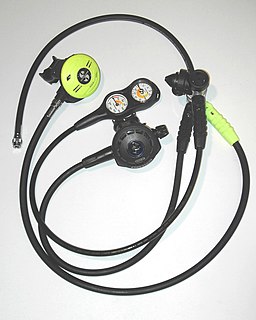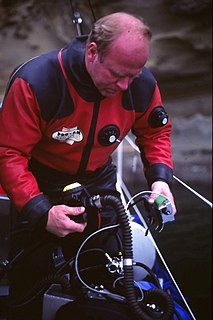Related Research Articles

A scuba set, originally just scuba, is any breathing apparatus that is entirely carried by an underwater diver and provides the diver with breathing gas at the ambient pressure. Scuba is an anacronym for self-contained underwater breathing apparatus. Although strictly speaking the scuba set is only the diving equipment that is required for providing breathing gas to the diver, general usage includes the harness by which it is carried, and those accessories which are integral parts of the harness and breathing apparatus assembly, such as a jacket or wing style buoyancy compensator and instruments mounted in a combined housing with the pressure gauge, and in the looser sense, it has been used to refer to all the diving equipment used by the scuba diver, though this would more commonly and accurately be termed scuba equipment or scuba gear. Scuba is overwhelmingly the most common underwater breathing system used by recreational divers and is also used in professional diving when it provides advantages, usually of mobility and range, over surface supplied diving systems, and is allowed by the relevant legislation and code of practice.

Trimix is a breathing gas consisting of oxygen, helium and nitrogen and is used in deep commercial diving, during the deep phase of dives carried out using technical diving techniques, and in advanced recreational diving.

A rebreather is a breathing apparatus that absorbs the carbon dioxide of a user's exhaled breath to permit the rebreathing (recycling) of the substantially unused oxygen content, and unused inert content when present, of each breath. Oxygen is added to replenish the amount metabolised by the user. This differs from open-circuit breathing apparatus, where the exhaled gas is discharged directly into the environment. The purpose is to extend the breathing endurance of a limited gas supply, and, for covert military use by frogmen or observation of underwater life, eliminating the bubbles produced by an open circuit system and in turn not scaring wildlife being filmed. A rebreather is generally understood to be a portable unit carried by the user. The same technology on a vehicle or non-mobile installation is more likely to be referred to as a life-support system.

A diving regulator is a pressure regulator that controls the pressure of breathing gas for diving. The most commonly recognised application is to reduce pressurized breathing gas to ambient pressure and deliver it to the diver, but there are also other types of gas pressure regulator used for diving applications. The gas may be air or one of a variety of specially blended breathing gases. The gas may be supplied from a scuba cylinder carried by the diver or via a hose from a compressor or high-pressure storage cylinders at the surface in surface-supplied diving. A gas pressure regulator has one or more valves in series which reduce pressure from the source, and use the downstream pressure as feedback to control the delivered pressure, or the upstream pressure as feedback to prevent excessive flow rates, lowering the pressure at each stage.

An electro-galvanic fuel cell is an electrochemical device which consumes a fuel to produce an electrical output by a chemical reaction. One form of electro-galvanic fuel cell based on the oxidation of lead is commonly used to measure the concentration of oxygen gas in underwater diving and medical breathing gases.

The Soviet, later Russian IDA71 military and naval rebreather is an oxygen rebreather intended for use by naval and military divers including Russian commando frogmen. As supplied it is in a plain backpack harness with no buoyancy aid. The casing is pressed aluminium with a hinged cover. It has a small optional nitrox cylinder which can be clipped on its outside to convert it to nitrox mode. It contains one oxygen cylinder and two absorbent canisters. In the bottom of its casing is an empty space which is intended for an underwater communications set.

The Clearance Divers Breathing Apparatus (CDBA) is a type of rebreather made by Siebe Gorman in England.

Scuba diving is a mode of underwater diving whereby divers use breathing equipment that is completely independent of a surface air supply. The name "scuba", an acronym for "Self-Contained Underwater Breathing Apparatus", was coined by Christian J. Lambertsen in a patent submitted in 1952. Scuba divers carry their own source of breathing gas, usually compressed air, affording them greater independence and movement than surface-supplied divers, and more time underwater than free divers. Although the use of compressed air is common, a gas blend with a higher oxygen content, known as enriched air or nitrox, has become popular due to the reduced nitrogen intake during long and/or repetitive dives. Also, breathing gas diluted with helium may be used to reduce the likelihood and effects of nitrogen narcosis during deeper dives.

Dräger is a German company based in Lübeck which makes breathing and protection equipment, gas detection and analysis systems, and noninvasive patient monitoring technologies. Customers include hospitals, fire departments and diving companies.

Porpoise is a tradename for scuba developed by Ted Eldred in Australia and made there from the late 1940s onwards. The first Porpoise was a closed circuit oxygen rebreather, and the following models were all single hose open circuit regulators.

Gordon Smith was an inventor, machinist and tool and die maker notable for inventing the KISS SCUBA diving rebreather.
The Lambertsen Amphibious Respiratory Unit (LARU) is an early model of closed circuit oxygen rebreather used by military frogmen. Christian J. Lambertsen designed a series of them in the US in 1940 and in 1944.

Scuba gas management is the aspect of scuba diving which includes the gas planning, blending, filling, analysing, marking, storage, and transportation of gas cylinders for a dive, the monitoring and switching of breathing gases during a dive, efficient and correct use of the gas, and the provision of emergency gas to another member of the dive team. The primary aim is to ensure that everyone has enough to breathe of a gas suitable for the current depth at all times, and is aware of the gas mixture in use and its effect on decompression obligations, nitrogen narcosis, and oxygen toxicity risk. Some of these functions may be delegated to others, such as the filling of cylinders, or transportation to the dive site, but others are the direct responsibility of the diver using the gas.

Rebreather diving is underwater diving using diving rebreathers, a class of underwater breathing apparatus which recirculate the breathing gas exhaled by the diver after replacing the oxygen used and removing the carbon dioxide metabolic product. Rebreather diving is practiced by recreational, military and scientific divers in applications where it has advantages over open circuit scuba, and surface supply of breathing gas is impracticable. The main advantages of rebreather diving are extended gas endurance, low noise levels, and lack of bubbles.

The Halcyon Passive, Variable Ratio-Biased Addition Semi-Closed rebreather is a unique design of semi-closed rebreather using a depth-compensated passive gas addition system. Passive addition implies that in steady state operation addition of fresh feed gas is a response to low volume of gas in the loop - the gas is injected when the top of the counterlung activates a demand type addition valve, which provides feed gas as long as the diver continues to inhale. The mechanism discharges gas to the environment in proportion to breathing volume to induce this gas feed.
The Halcyon RB80 is a non-depth-compensated passive addition semi-closed circuit rebreather of similar external dimensions to a standard AL80 scuba cylinder. It was originally developed by Reinhard Buchaly (RB) in 1996 for the cave exploration dives conducted by the European Karst Plain Project (EKPP).

The following index is provided as an overview of and topical guide to underwater diving:

A Diving rebreather is an underwater breathing apparatus that absorbs the carbon dioxide of a diver's exhaled breath to permit the rebreathing (recycling) of the substantially unused oxygen content, and unused inert content when present, of each breath. Oxygen is added to replenish the amount metabolised by the diver. This differs from open-circuit breathing apparatus, where the exhaled gas is discharged directly into the environment. The purpose is to extend the breathing endurance of a limited gas supply, and, for covert military use by frogmen or observation of underwater life, to eliminate the bubbles produced by an open circuit system. A diving rebreather is generally understood to be a portable unit carried by the user, and is therefore a type of self-contained underwater breathing apparatus (scuba). A semi-closed rebreather carried by the diver may also be known as a gas extender. The same technology on a submersible or surface installation is more likely to be referred to as a life-support system.
References
- 1 2 3 4 5 Chapple, JCB; Eaton, David J. "Development of the Canadian Underwater Mine Apparatus and the CUMA Mine Countermeasures dive system". Defence R&D Canada Technical Report. Defence R&D Canada (DCIEM 92–06). Archived from the original on August 8, 2009. Retrieved 2009-03-31.
{{cite journal}}: CS1 maint: unfit URL (link) - ↑ Micjan, Ron (2006). "Canadian Forces CUMA Rebreather". TMIShop.com. Retrieved 2009-04-06.